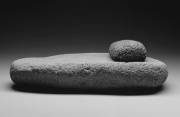Difference between revisions of "Igneous"
Jump to navigation
Jump to search
m (Text replace - "== Authority (list of sources check for information on this record)==" to "== Sources Checked for Data in Record ==") |
|||
| Line 8: | Line 8: | ||
igneo (Esp., Port.); ignée (Fr.); Magmatisch (Deut.) | igneo (Esp., Port.); ignée (Fr.); Magmatisch (Deut.) | ||
| − | == | + | == Sources Checked for Data in Record == |
* G.S.Brady, ''Materials Handbook'', McGraw-Hill Book Co., New York, 1971 | * G.S.Brady, ''Materials Handbook'', McGraw-Hill Book Co., New York, 1971 | ||
Revision as of 10:46, 29 April 2016
Description
Rocks that solidified from a hot, molten matrix such as Magma or Lava. When the magma cools slowly, individual components can crystalline and form coarse-grain rocks, such as Granite, Diorite, Basalt, and Syenite. When the magma or lava cools quickly, fine-grain minerals and glass-like rocks, such as Rhyolite and Obsidian, are formed.
Synonyms and Related Terms
igneo (Esp., Port.); ignée (Fr.); Magmatisch (Deut.)
Sources Checked for Data in Record
- G.S.Brady, Materials Handbook, McGraw-Hill Book Co., New York, 1971
- Anne Grimmer, Glossary of Building Stone Terms, A Glossary of Historic Masonry Deterioration Problems and Preservation Treatments, National Park Service, Washington DC, 1984
- Van Nostrand's Scientific Encyclopedia, Douglas M. Considine (ed.), Van Nostrand Reinhold, New York, 1976
- Random House, Webster's Encyclopedic Unabridged Dictionary of the English Language, Grammercy Book, New York, 1997
- The American Heritage Dictionary or Encarta, via Microsoft Bookshelf 98, Microsoft Corp., 1998
